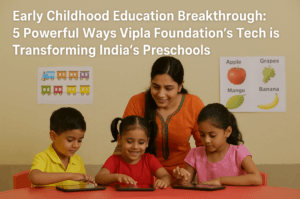Early Childhood Education Breakthrough: 5 Powerful Ways Vipla Foundation’s Tech is Transforming India’s Preschools
The Vipla Foundation’s innovative use of technology is transforming early childhood education (ECE) in India’s underserved communities. By integrating the Umang app across Mumbai’s Balwadis (preschools), the organization tackles systemic challenges like chronic absenteeism through real-time attendance tracking, enabling teachers to intervene with parents or home visits. The app’s Classroom Learning Evaluation (CLE) tool monitors 80+ developmental indicators, generating actionable insights to tailor lesson plans and address learning gaps.
Mentorship is strengthened via a companion app, where trainers assess educators’ skills and provide targeted support, fostering a culture of continuous growth. Collaboration with municipal authorities ensured the tool’s adaptation to public systems, scaling it across 900 BMC-run centers. By bridging tech with grassroots needs—through offline access, intuitive design, and hands-on teacher training—Vipla demonstrates how data-driven strategies can align policy goals with on-ground realities.
This model not only improves learning outcomes but also empowers educators, engages families, and advocates for systemic investment in ECE, offering a replicable blueprint for equitable, quality education nationwide.

Early Childhood Education Breakthrough: 5 Powerful Ways Vipla Foundation’s Tech is Transforming India’s Preschools
Early childhood education (ECE) in India faces significant hurdles—fragmented systems, inconsistent quality, and low awareness of its importance. The Vipla Foundation’s innovative use of technology in Mumbai’s Balwadis (preschool centers) offers a blueprint for addressing these challenges, demonstrating how strategic tech integration can transform learning outcomes, teacher effectiveness, and systemic accountability.
The Challenge: Fragmented Systems and Missed Opportunities
India’s ECE landscape spans Anganwadis, private preschools, and community-run centers, leading to uneven access and quality. While the National Education Policy (NEP) 2020 aims to universalize ECE by 2030, gaps persist. Children in underserved communities often miss critical foundational learning due to absenteeism, untrained educators, and a lack of data-driven interventions.
Vipla’s Tech-Driven Solution: The Umang App
In 2020, Vipla launched the Umang STCI Teacher app across its 47 Community Balwadis, later expanding it to 900 BMC-run centers. The app tackles three core challenges:
Combatting Absenteeism with Real-Time Tracking
- Problem: Irregular attendance disrupts learning continuity.
- Solution: Umang’s attendance tracking feature flags patterns—like a child missing 12+ days—enabling teachers to intervene through parent outreach or home visits.
- Impact: Mentors report improved parental engagement and a cultural shift in recognizing ECE’s value. Teachers now proactively address barriers, from health issues to seasonal migration.
Measuring Development with Classroom Learning Evaluations (CLE)
- Problem: Subjective assessments failed to capture holistic progress.
- Solution: CLE tools track 80+ developmental indicators (e.g., language, motor skills) monthly, auto-generating progress dashboards.
- Impact: Teachers adjust lesson plans based on data. For example, low scores in verbal communication prompted storytelling workshops. Over time, teachers advocated refining assessment parameters, showing deepened understanding of child development.
Strengthening Teachers Through Mentorship
- Problem: Limited support left educators isolated.
- Solution: The Mentor App complements in-person visits with tools like the Teacher Observation Tool (TOT) and Quality Evaluation and Assessment of Teachers (QEAT).
- Impact: Mentors identify training needs (e.g., classroom management) and track growth via pre/post-training tests. Teachers now request skill-specific workshops, fostering a culture of continuous improvement.
Collaboration and Scaling: Lessons from the Field
- Government Partnerships: Vipla’s collaboration with the BMC required tailoring Umang to municipal needs, such as removing report cards to prevent student transfers. Trust-building with nonprofits and officials was key to scaling.
- User-Centric Design: Dropdown menus, offline access, and peer learning eased tech adoption among teachers, many of whom initially struggled with smartphones.
- Data-Driven Advocacy: Aggregated CLE and attendance data informed policy dialogues, aligning Vipla’s model with NEP 2020 goals.
Broader Implications: A Model for Systemic Change
Vipla’s success underscores actionable strategies for EdTech in low-resource settings:
- Invest in On-Ground Support: Training and mentorship bridge the tech-literacy gap.
- Prioritize Feedback Loops: Regular input from teachers and mentors ensures tools evolve to meet real needs.
- Leverage Data for Advocacy: Transparent metrics build stakeholder buy-in, from parents to policymakers.
The Road Ahead
Vipla plans to expand Umang to other regions and integrate AI to predict dropout risks. Their experience highlights a critical insight: Technology, when paired with human-centric support, doesn’t just measure progress—it drives it. For India to achieve its ECE goals, scalable, collaborative models like this will be essential.
Call to Action: Organizations and policymakers can replicate this approach by:
- Partnering with local communities to co-design tech solutions.
- Allocating resources for teacher mentorship alongside digital tools.
- Using data to advocate for systemic investments in ECE.
In a sector often hindered by silos, Vipla’s model proves that innovation, when rooted in empathy and collaboration, can lay the foundation for lifelong learning.
You must be logged in to post a comment.